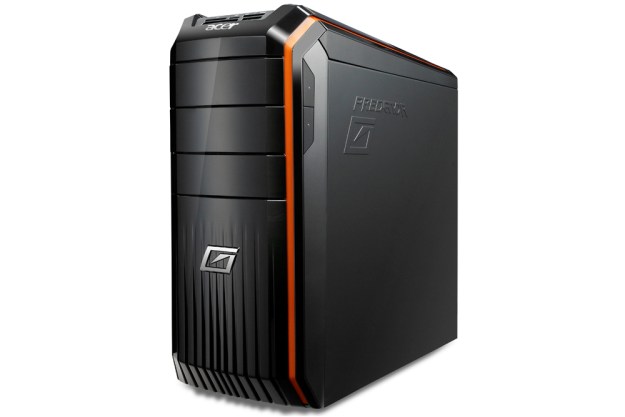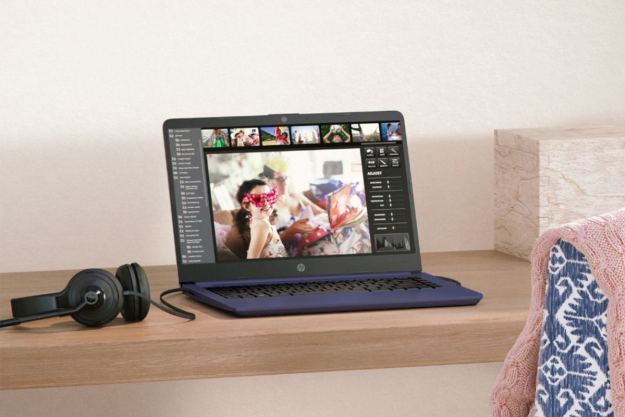
“Acer has constructed a middle-ground system that’s palatable for gamers on the budget but doesn’t impress.”
- Accessible connectivity
- Strong processor performance
- Cool, quiet operation
- Low power consumption
- Inexpensive
- So-so build quality
- Difficult to upgrade
- Poor peripherals
- Merely adequate game performance
The halls of gaming are adorned with the names of niche brands like Alienware, Falcon Northwest and Origin. This is actually a bit strange – after all, large companies have managed to conquer every other section of the PC market. Yet gamers still seem to identify with the most hardcore of the hardcore. Only Dell and Asus have impressed this tough crowd, and only with significant, concentrated effort.
Other major manufacturers, including Acer, have tried for years to earn the same respect. And why not? While analysts mutter about the imminent death of the desktop computer, PC gamers are spending more money than ever before. Happy gamers make good customers.
Acer’s latest effort, the Predator AG3620-UR12, is a response to passionate gamers searching for powerful, affordable hardware. The result is a system that retails at $1,300, yet also offers a Core i7-3770 processor and Radeon HD 8760 graphics card. That’s a lot of power for a low price, but can this Predator stalk larger prey?
Just a hint of flair
Not everyone will peg this desktop as a gaming computer at first glance. Though the tower does predominantly feature Acer’s gaming logo, a stylized chrome G, the system is otherwise tepid. Orange stripes of inlaid plastic are the only sporting touch, yet this is no more exciting that the color found on Dell XPS or high-end HP Pavilion systems.

Still, the computer is attractive enough, and some will prefer the reserved exterior. Users may also enjoy the relatively compact dimensions. Though not small, this system is no larger than the average mid-range desktop PC. Finding room for it on or under a desk isn’t difficult.
Build quality also compares to a mid-range desktop, which is disappointing. Gaming computers, even inexpensive ones, often ship in enclosures that are a step above the norm. Yet Acer’s plastic-clad Predator seems no more expensive than PCs the company sells for half the price. All surfaces a user might touch are covered in glossy plastic that looks cheap and feels flimsy.
Functional on the outside, confusing on the inside
A convenient panel of ports, which includes two USB 2.0 and two USB 3.0 along with headphone and microphone jacks, can be found on the system’s top edge. A card reader is also placed nearby. We like that Acer has kept front-facing connectivity in a single, central location that’s easy to access from almost any angle.
Around back connectivity is complimented with six additional USB ports (four 2.0, two 3.0), DVI, HDMI, DisplayPort, 2.1 audio and old-fashioned serial keyboard and mouse ports. This last trait may seem odd, but gamers will appreciate it. Gaming keyboards often use serial ports because they can register an unlimited number of simultaneous key activations.
Opening the Predator is simple. Only two screws must be removed from the left side and the case, once open, provides clear access to the processor, video card and RAM. These basic upgrades can be performed within minutes and the enclosure can fit most video cards on the market today.
When we tried to remove other panels, however, the system stumped us. There’s no apparent way to remove the front without first removing the right side panel, yet there’s also no way to remove the right side panel without first removing the front. We referred the desktop’s documentation but found it only provided instructions on how to replace RAM, which doesn’t require removal of these panels. This flaw will make motherboard, optical-drive and hard-drive upgrades difficult for users to install.
Acer does provide a hot-swap drive bay below the optical drive to off-set this problem, but that bay accepts a single hard drive. Want to add a third or upgrade to a solid-state drive? You’re in for frustration.
Poor peripherals
Acer ships this system with an underwhelming pair of peripherals that would be only adequate for a home office computer. The mouse is small and equipped with just two buttons while the keyboard is a standard Acer media peripheral. Neither includes gaming features like backlighting, on-the-fly sensitivity adjustment or macros.

Acer should learn from the boutiques. Serious gamers often prefer a particular keyboard or mouse and probably already own their weapons of choice. Bundling a cheap keyboard and mouse is a waste of time and money.
Sport compact
Our review unit arrived with an unusual hardware combination that pairs an extremely quick Intel Core i7-3770 processor with 32GB (yes, thirty-two!) of RAM and a spanking-new Radeon HD 8760 video card.
The powerful Core i7 turned in excellent processor benchmark scores. SiSoft Sandra reached a result of 117 GOPS while 7-Zip came to a combined score of 22,236. These figures are just south of more expensive configurations we’ve tested, such as the Digital Storm Bolt and Falcon Northwest Tiki. This, combined with the pile of the memory, makes the Predator a convincing budget workstation.
PCMark 7 was less enthusiastic, however, as it came to mundane score of 3,046. The lack of a solid-state drive holds the system back, and while it does ship with a cache drive that lowers boot times, the use of slower mechanical storage is often noticeable when loading a game.
3DMark 11 turned in a score of 12,621 in the Cloud Gate test and 2,437 in the Fire Strike test. These numbers don’t compare favorably to the Digital Storm Bolt’s respective scores of 20,713 and 4,593. The Bolt configuration we tested also retails for about $300 more, however, and the Predator would be at least as quick if that money was put towards upgrading the video card. Acer unfortunately doesn’t offer this as a factory option.
Despite ho-hum benchmark scores, the Predator can handle modern games. The Elder Scrolls V: Skyrim ran at 50 to 60 frames per second (the cap in that game) when played at 1080p and High detail. Diablo 3 ran at between 40 and 70 FPS with the same settings and Dawn Of War 2: Retribution turned in a score of 63.6 FPS at Ultra detail when we ran the game’s built-in benchmark.
Keep it secret
Like the Predator of movie fame, Acer’s desktop is able to do its work without attracting attention. Our decibel meter registered a maximum of 41.1 decibels at idle. This figure increased to only 42.8 when the system was at full load. Though audible in a quiet room, the tower’s fans are never distracting and often lost in the chaos of a good game.
Power consumption tests turned in excellent results. At idle the system ate only 42 watts, and that number increased to just 136 watts during our graphical stress test. Gamers who care about efficiency should give this desktop consideration.
Conclusion
Acer’s Predator falls afoul of the same issues that have plagued every major manufacturer’s attempt to enter the gaming space. Though competent, the system’s hardware is designed to serve up an impressive specification sheet instead of awesome gaming. So much more could have been offered if the powerful processor and gobs of RAM were exchanged for a quicker video card. We’re also disappointed to see upgradability spoiled by the fussy enclosure.
Still, $1,300 is fair for a desktop that can play games at 1080p and high detail. There are some competitors that offer more bang for the buck, but only a few, and most have their value off-set by other disadvantages.
This system also serves well as a general-purpose PC. It’s quick, small, serves up a healthy buffet of ports and stays quiet under load. These traits make it a desktop easy to live with.
Acer has constructed a middle-ground system that’s palatable for gamers on the budget but doesn’t impress. Though competent, this desktop is a perfect example of why big companies often fail to attract hardcore gamers. The Predator is just a few tweaks short of awesome, yet those tweaks make all the difference.
Highs:
- Accessible connectivity
- Strong processor performance
- Cool, quiet operation
- Low power consumption
- Inexpensive
Lows:
- So-so build quality
- Difficult to upgrade
- Poor peripherals
- Merely adequate game performance







